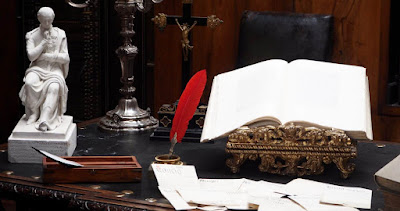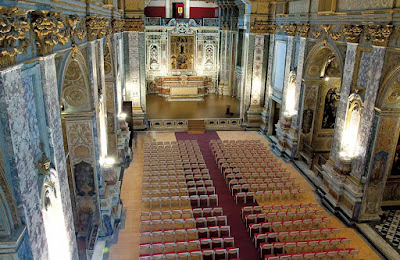There is a saying: “See Naples, and then die.” This phrase, coined by the German poet Goethe during his visit, reflects his deep admiration for the city’s sunlit charm, its art, its people, and its vibrant atmosphere. I wholeheartedly echo Johann Wolfgang von Goethe's sentiments. Naples is a city I continually fall in love with, and not just for its culinary delights, but for its ART.
Yes, you heard it right – ART!
This post is dedicated to those eager to uncover the treasures hidden within the museums scattered throughout the city center, as well as those tucked away in churches and monumental complexes.
Let’s dive in!
Naples boasts a plethora of museums, some renowned worldwide while others remain hidden gems off the beaten path. For this guide, I've selected those situated in the heart of the Centro Storico, along with a few near the bay.
A Few Words of Advice:
Limit your visits: Aim to explore no more than two museums in a single day to avoid rushing and to truly savor each experience.
Take advantage of offers: If you’re in the area for several days, consider checking out options like the Naples or Campania Artecard, which provide discounts or even free entry to all the museums featured in my list.
If you're a fan of ancient artifacts, the Archaeological Museum of Naples is a must-visit. One of the world's most significant archaeological museums, it features an extraordinary collection of ancient Greek and Roman art, founded in the late 18th century by King Charles VII. The extensive collection includes sculptures, frescoes, mosaics, pottery, and jewelry from the 2nd millennium BCE to the 6th century CE. Notably, the Farnese Collection houses the Farnese Bull, the largest sculpture from antiquity. The museum also contains artifacts from Pompeii and Herculaneum, buried by Mount Vesuvius in 79 CE, along with a library of over 100,000 volumes, a conservation lab, and a restoration workshop. Be sure to check the website for current exhibitions.
Founded in 1883, the museum is dedicated to celebrating the life and contributions of Gaetano Filangieri, an 18th-century philosopher, jurist, and economist. Its collection features an array of paintings, sculptures, and decorative arts spanning from the 16th to the 19th century. A standout attraction of the museum is its remarkable collection of historic Neapolitan nativity scenes, famously known as presepi.
The Castel Nuovo in Naples stands out as a significant landmark for visitors. Here are some intriguing Gothic features of the castle that you may find captivating:
The Sala dei Baroni: This reception room boasts a stunning Gothic vaulted ceiling and frescoes that date back to the fifteenth century.
The Towers: The castle is adorned with multiple towers, including the impressive Torre del Maschio, which rises 40 meters high and offers a panoramic view of the city.
The Portals: You'll find several Gothic portals at the castle, notably the Portal of San Gennaro and the Portal of Capuana.
If you appreciate science and art, visit this museum located in the ancient Ospedale degli Incurabili courtyard. The sixteenth-century baroque building houses ancient surgical tools, medical devices, microscopes, and publications on anatomy and theatre skills from the Neapolitan Medical School. Exhibits honor notable figures like Moscati, Cotugno, and Cirillo, and feature the 1700s Pharmacy of Incurabili, a Baroque-Rococo masterpiece.
The Donnaregina Monumental Complex is a historic site that encompasses the Museo Diocesano Napoli, a museum dedicated to the art and history of the Archdiocese of Naples. This complex comprises several buildings, including the Church of Santa Maria Donnaregina Vecchia, which dates back to the 14th century.
The museum's collection features a variety of paintings, sculptures, liturgical objects, and other artifacts spanning from the Middle Ages to the present day. Among the most remarkable works in the collection are pieces created by renowned artists such as Caravaggio, Luca Giordano, and Jusepe de Ribera.
Pio Monte della Misericordia is a charitable organization founded in Naples, Italy, in 1602. The organization's motto is "Misericordia et caritas," which means "Mercy and Charity" in Latin. The organization is known for its iconic painting "The Seven Works of Mercy" by Caravaggio, which is on display in the organization's church. So, if you are a fan of Caravaggio, this is a must.
Located in Naples' Piazza del Plebiscito, the Royal Palace of Naples (Palazzo Reale) was built in the 17th century for the Spanish Viceroys and served as the Bourbon Kings' residence until Italy's unification in 1861. With over 1,200 rooms, it is one of the world's largest royal residences, featuring a Baroque façade and a wealth of artworks. The palace also contains the National Library of Naples, holding over 1.5 million volumes. Visitors can explore the apartments, gardens, and rooftop, with varying hours and prices available online.
When exploring Naples, the Galleria Borbonica, also known as the Bourbon Tunnel, is an absolute must-see. Beneath one of Italy's busiest cities lies an underground marvel that dates back to 1853. It was then that Ferdinand II of Bourbon commissioned architect Errico Alvino—an exceptional overseer for Via Chiaia and S. Ferdinando—to create an underground viaduct. This structure, which runs beneath Monte Echia, connected the Royal Palace with Piazza Vittoria, located near the sea and the barracks.
Moreover, it served as a military escape route for the Bourbon dynasty. During World War II, these tunnels transformed into a bomb shelter and even a makeshift hospital.
There are multiple entrances to this fascinating underground site. Be sure to check out the options and choose the one you’d like to explore. Personally, I favor the 'Morelli entrance.'
Napoli Sotterranea is a vast underground network of tunnels, cisterns, and passageways that date back to the ancient Greek and Roman eras. The tunnels of Napoli Sotterranea were originally used for water storage, but later served as a refuge during times of war and as a hiding place for smugglers. The underground network covers more than 80 kilometers and includes features such as catacombs, ancient quarries, and even a hidden river. Some of the most interesting sites within Napoli Sotterranea include the Greco-Roman aqueduct, the underground market, and the World War II air raid shelter. Note: There are parts of the tunnel which can get pretty narrow, so if you are claustraphobic, you may want to speak to the guide or maybe opt out on this one.
The Complesso Monumentale San Domenico Maggiore is a historic complex located in the heart of te city and is home to the Church of San Domenico Maggiore, which was built in the 13th century and is known for its impressive Gothic architecture. The complex also includes a monastery, which was originally built in the 14th century and has been expanded and renovated over the centuries. Many notable figures are buried in the church, including the Italian philosopher and theologian Thomas Aquinas. The complex is also home to a number of important works of art, including frescoes by Renaissance artist Pietro Cavallini and a painting by Caravaggio.
Gallerie d'Italia - Napoli is an art museum and is one of three Gallerie d'Italia museums in Italy, with the other two located in Milan and Vicenza. The museum's collection includes works by Italian artists such as Caravaggio, Giorgio de Chirico, and Renato Guttuso. Fun fact: The building that houses the museum was originally built in the 19th century as a bank and was later restored and converted into a museum.
Breathtaking and moving. Each step that I took in this monumental complex left me in awe. But I'm getting ahead of myself. A little background. The complex is located in the center of the city, barely noticeable on a little side street. It was built in 1500 and was used as a convent and church. Over the centuries, it has been expanded and modified, becoming an example of Baroque architecture. Today, the complex houses the Civic Museum of Castel Nuovo, where you can admire important collections of art and objects of everyday life. You've got to visit the church as well. And here is a fun fact- The complex also houses the tomb of Vlad III of Transylvania.
San Gennaro is the patron Saint of Naples-and in the Duomo basilica, there is a small museum that houses the treasures of San Gennaro. A museum which features a priceless heritage of devotional objects made of gold, silver, bronze and precious stones. Over the centuries these riches have been donated to San Gennaro by Neapolitan and foreign kings, by Popes and by the people.
In conclusion, Naples is a city that offers a rich tapestry of history, culture, and art, seamlessly woven into its vibrant present. The museums and monumental complexes scattered across this enchanting city not only showcase an extraordinary array of artworks and artifacts but also tell the stories of Naples' past and its enduring spirit. From the ancient treasures of the Archaeological Museum to the breathtaking underground marvels of Napoli Sotterranea, each site offers a unique glimpse into the city's heart and soul. Whether you're an art aficionado, a history buff, or simply a curious traveler, Naples' museums provide a profound and moving experience that will leave you inspired and eager to return. So, as you explore these magnificent museums, take your time, soak in the beauty, and let Naples cast its spell on you.






.jpg)
.jpg)


.jpg)
.jpg)
.jpg)
.jpg)










